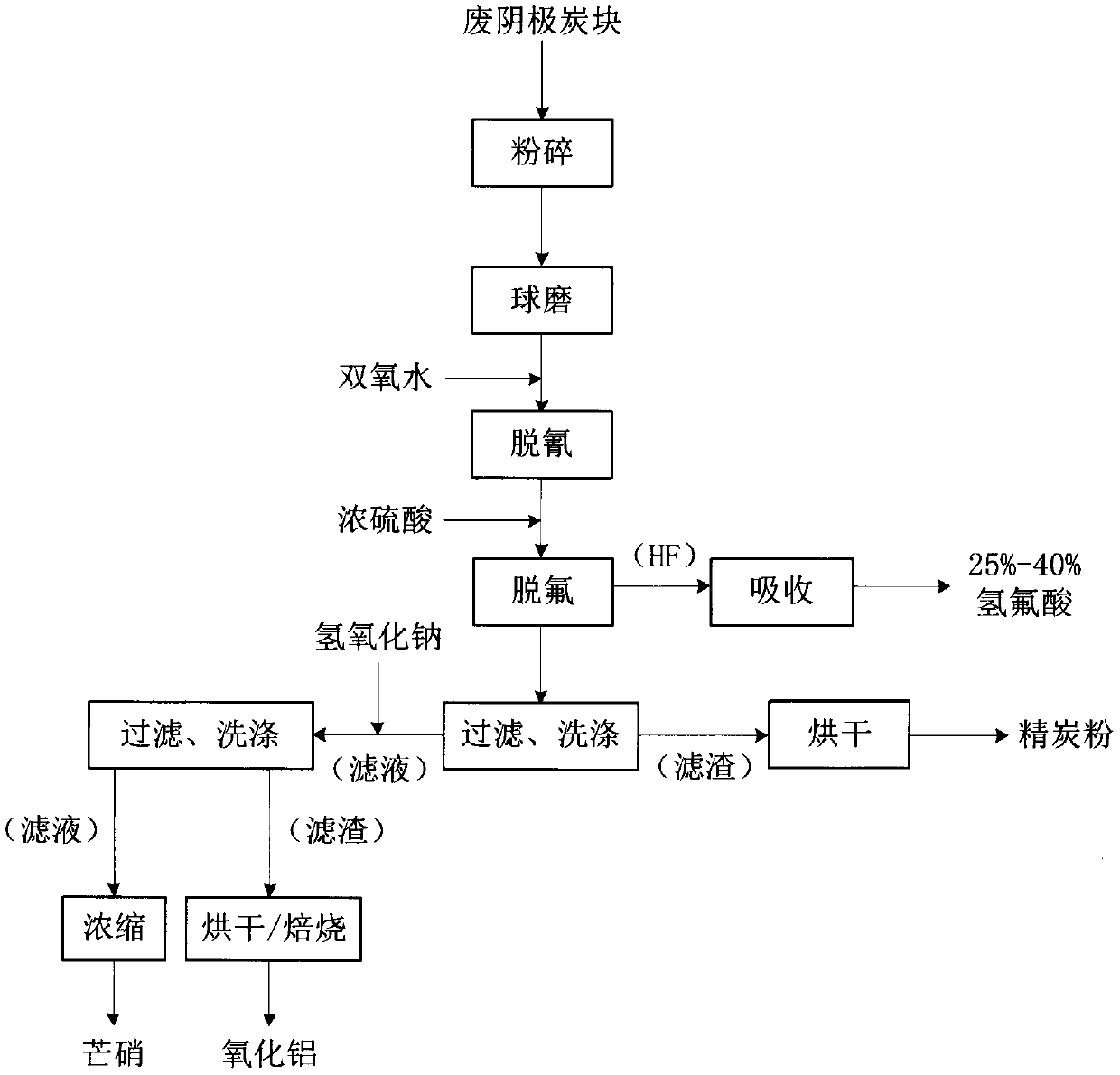Recycling method for waste cathode carbon blocks of electrolytic aluminum electrolysis cell
A waste cathode carbon block and electrolytic cell technology, which is applied in the preparation/purification of carbon, alumina/aluminum hydroxide, fluorine/hydrogen fluoride, etc., can solve the problems of HF pollution, secondary pollution, deterioration of production conditions, etc. Advanced technology, obvious advantages, and the effect of recycling
- Summary
- Abstract
- Description
- Claims
- Application Information
AI Technical Summary
Problems solved by technology
Method used
Image
Examples
Embodiment 1
[0013] A method for recycling waste and old cathode carbon blocks of electrolytic aluminum electrolytic cells, the processing process comprising the following steps: crushing and grinding the raw materials of waste and old cathode carbon blocks of electrolytic aluminum electrolytic cells to carbon powders smaller than 45 meshes; : 1 adding 10g concentration is 30wt% hydrogen peroxide, stirs 10min to decompose cyanide and excess hydrogen peroxide at 80 ℃, 50rpm; With the material that removes cyanide, add 50g concentration and be 95wt% thick Sulfuric acid, at 120°C and a stirring speed of 100rpm, generates HF gas; passes HF gas into the hydrogen fluoride condensation absorption tower, absorbs it with deionized water or low-concentration hydrofluoric acid cycle, and obtains high-concentration hydrogen fluoride with a concentration of 28.8wt% Acid; the carbon powder after removing fluorine is cooled to room temperature, and the concentration is 40wt% NaOH aqueous solution is added...
Embodiment 2
[0015] A method for recycling waste and old cathode carbon blocks of electrolytic aluminum electrolytic cells, the processing process comprising the following steps: crushing and grinding the raw materials of waste and old cathode carbon blocks of electrolytic aluminum electrolytic cells to carbon powders smaller than 45 meshes; : 1 add 10g concentration of hydrogen peroxide that is 30wt%, stir 20min at 80 ℃, 100rpm to decompose cyanide and excess hydrogen peroxide; With the material that removes cyanide, add 70g concentration and be 95wt% concentrated Sulfuric acid, at 120°C and a stirring speed of 150 rpm, generates HF gas; passes the HF gas into the hydrogen fluoride condensation absorption tower, and absorbs it with deionized water or low-concentration hydrofluoric acid to obtain high-concentration hydrogen with a concentration of 25.0 wt%. Fluoric acid: the carbon powder after removing fluorine is cooled to room temperature, and the concentration is 40wt% NaOH aqueous solu...
Embodiment 3
[0017]A method for recycling waste and old cathode carbon blocks of electrolytic aluminum electrolytic cells, the processing process comprising the following steps: crushing and grinding the raw materials of waste and old cathode carbon blocks of electrolytic aluminum electrolytic cells to carbon powders smaller than 45 meshes; : 1 add 10g concentration of 30wt% hydrogen peroxide, stir at 80°C and 100rpm for 30min to decompose cyanide and excess hydrogen peroxide; to remove the material of cyanide, add 60g concentration of 98wt% concentrated Sulfuric acid, at 120°C and a stirring speed of 200 rpm, generates HF gas; passes the HF gas into the hydrogen fluoride condensation absorption tower, and absorbs it with deionized water or low-concentration hydrofluoric acid to obtain high-concentration hydrogen with a concentration of 40.0wt% Fluoric acid: the carbon powder after removing fluorine is cooled to room temperature, and the concentration is 40wt% NaOH aqueous solution is added...
PUM
 Login to View More
Login to View More Abstract
Description
Claims
Application Information
 Login to View More
Login to View More - R&D
- Intellectual Property
- Life Sciences
- Materials
- Tech Scout
- Unparalleled Data Quality
- Higher Quality Content
- 60% Fewer Hallucinations
Browse by: Latest US Patents, China's latest patents, Technical Efficacy Thesaurus, Application Domain, Technology Topic, Popular Technical Reports.
© 2025 PatSnap. All rights reserved.Legal|Privacy policy|Modern Slavery Act Transparency Statement|Sitemap|About US| Contact US: help@patsnap.com

